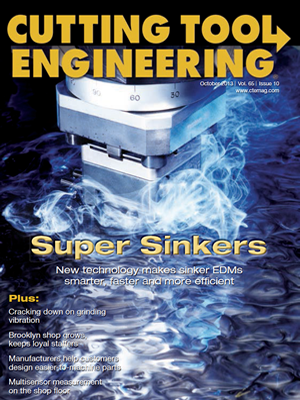During the summer, it gets pretty hot in a shop that’s not air conditioned. With sweat running down my semibald head, I was trying to get a part set up in a CNC lathe. This particular part was giving me some trouble because of a tool compensation problem. I was hot and frustrated.
To make matters worse, a big, fat, bluebottle fly was buzzing around my sweaty head. Periodically, the little carrion-eating pest would land in a droplet of sweat that still happened to be connected to my head. With maddening regularity, it would do its little bird bath dance in the sweat droplet and flee as soon as I tried to swipe at it with my dirty paw. This went on for a while as I worked on my programming problem.
Now, I consider myself a pretty patient person, but this was bordering on a declaration of open hostility. Each time the fly landed on my head, it was like the programming gods were sending some kind of message to me, reminding me of my flaws as a programmer again and again. I wonder what hell looks like for CNC programmers. My best guess is an endless string of cryptic error messages followed by eternal heartrending machine crashes or near misses—while in an elevated-temperature environment with a fly thrown in for good measure.
The next hour felt like an inquisition conducted by an expert interrogator. Eventually, however, my feelings about the process went from anger to resignation. After a couple hours of fighting this fly, I guess I reached the second stage of my downward spiral. I think it happened after I wiped my head off a few times to keep the diabolical critter from landing. I just gave up and let him creep around my scalp, licking the salt deposits with his hairy little suction tube.
I have sometimes experienced moments of almost divine understanding when I mentally give up but keep plugging away. That’s what happened in this situation. I finally figured out the problem with the program. I felt a rush of mental relief at solving the problem and a renewed surge of loathing for my winged nuisance.
As always, I tested the program and was finally ready to run it in earnest on real parts. I had run a couple parts and tweaked the wear offsets, so everything was ready to run. For this part, I had set up a bar puller and part counter. It was a small part, so I could run more than 100 pieces unattended.
I opened the enclosure one last time to double check everything and the fly flew inside the lathe enclosure. Bam! The wind from me slamming the door closed probably killed him, but let me tell you, it was still pure pleasure to push “cycle start.” I was not going to open that door unless the collet nose flew off. I imagined that for the fly it was like going through a car wash in a convertible with the top down, except the car wash was spewing a mixture of oil, water and shards of metal.
I might just have the tiniest bit of understanding of how it feels to be tied to a chair in a dank dungeon being asked for the millionth time, “Did you check the nose radius compensation? We know you didn’t. Why don’t you make it easy on yourself and just tell us. This is hurting us more than it’s hurting you.” At that moment, when you are ready to throw in the towel and say anything to make it stop, three Green Berets kick the door in.
“G41 to you, dirt bag,” echoes off the stone walls of your soon-to-be-vacated hell. It was that satisfying. CTE
About the Author: Tom Lipton is a career metalworker who has worked at various job shops that produce parts for the consumer product development, laboratory equipment, medical services and custom machinery design industries. He has received six U.S. patents and lives in Alamo, Calif. For more information, visit his blog at oxtool.blogspot.com and video channel at www.youtube.com/user/oxtoolco. Lipton’s column is adapted from information in his book “Metalworking Sink or Swim: Tips and Tricks for Machinists, Welders, and Fabricators,” published by Industrial Press Inc., South Norwalk, Conn. The publisher can be reached by calling (888) 528-7852 or visiting www.industrialpress.com. By indicating the code CTE-2013 when ordering, CTE readers will receive a 20 percent discount off the book’s list price of $44.95.
Related Glossary Terms
- collet
collet
Flexible-sided device that secures a tool or workpiece. Similar in function to a chuck, but can accommodate only a narrow size range. Typically provides greater gripping force and precision than a chuck. See chuck.
- computer numerical control ( CNC)
computer numerical control ( CNC)
Microprocessor-based controller dedicated to a machine tool that permits the creation or modification of parts. Programmed numerical control activates the machine’s servos and spindle drives and controls the various machining operations. See DNC, direct numerical control; NC, numerical control.
- land
land
Part of the tool body that remains after the flutes are cut.
- lathe
lathe
Turning machine capable of sawing, milling, grinding, gear-cutting, drilling, reaming, boring, threading, facing, chamfering, grooving, knurling, spinning, parting, necking, taper-cutting, and cam- and eccentric-cutting, as well as step- and straight-turning. Comes in a variety of forms, ranging from manual to semiautomatic to fully automatic, with major types being engine lathes, turning and contouring lathes, turret lathes and numerical-control lathes. The engine lathe consists of a headstock and spindle, tailstock, bed, carriage (complete with apron) and cross slides. Features include gear- (speed) and feed-selector levers, toolpost, compound rest, lead screw and reversing lead screw, threading dial and rapid-traverse lever. Special lathe types include through-the-spindle, camshaft and crankshaft, brake drum and rotor, spinning and gun-barrel machines. Toolroom and bench lathes are used for precision work; the former for tool-and-die work and similar tasks, the latter for small workpieces (instruments, watches), normally without a power feed. Models are typically designated according to their “swing,” or the largest-diameter workpiece that can be rotated; bed length, or the distance between centers; and horsepower generated. See turning machine.
- relief
relief
Space provided behind the cutting edges to prevent rubbing. Sometimes called primary relief. Secondary relief provides additional space behind primary relief. Relief on end teeth is axial relief; relief on side teeth is peripheral relief.


